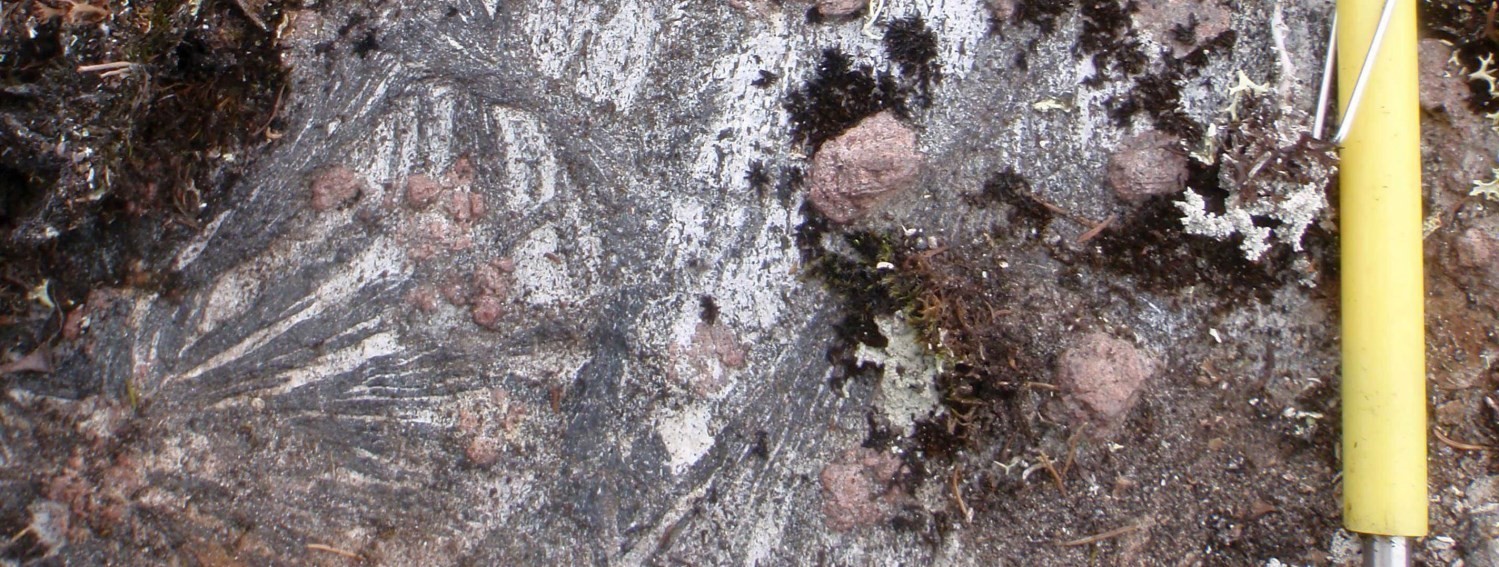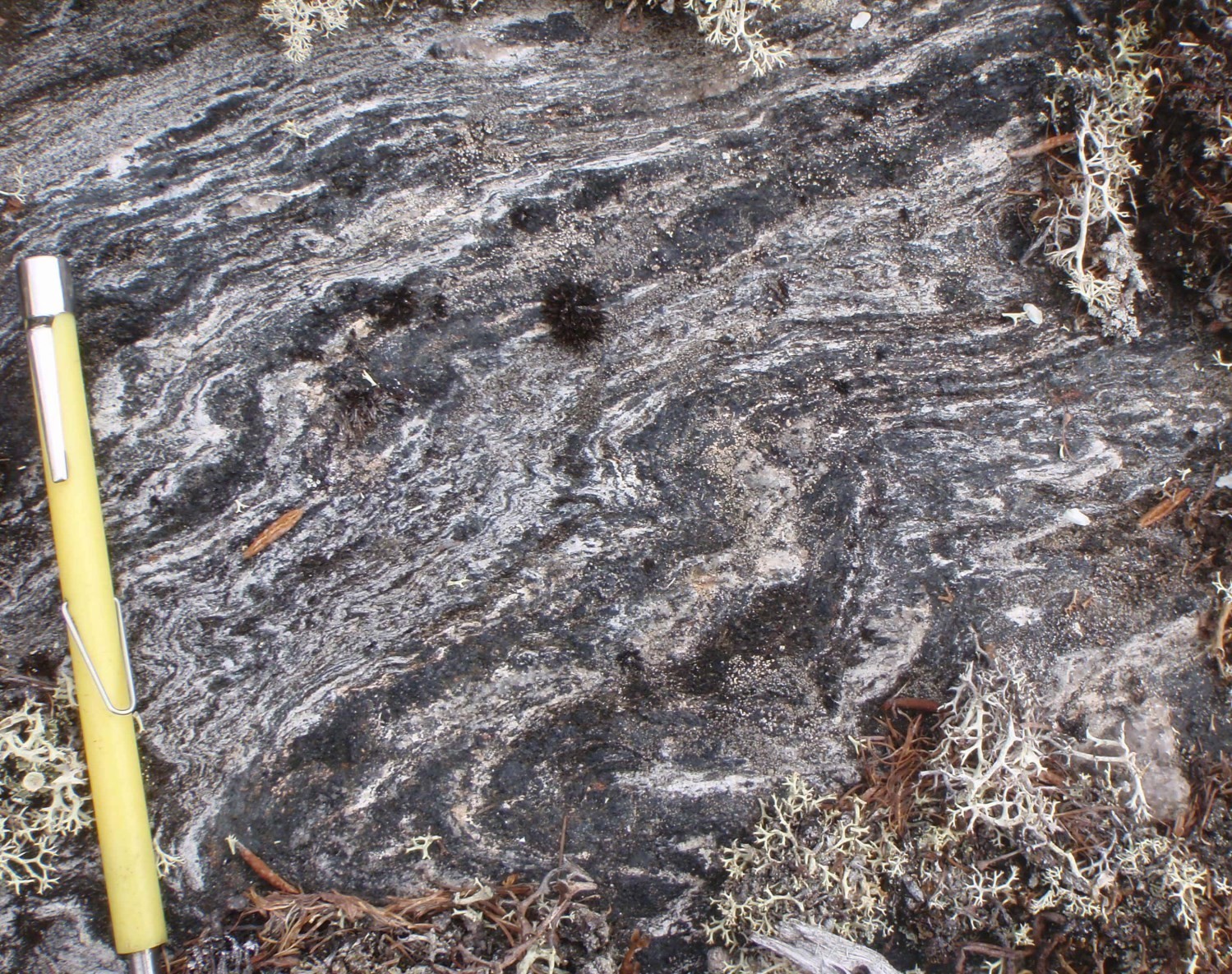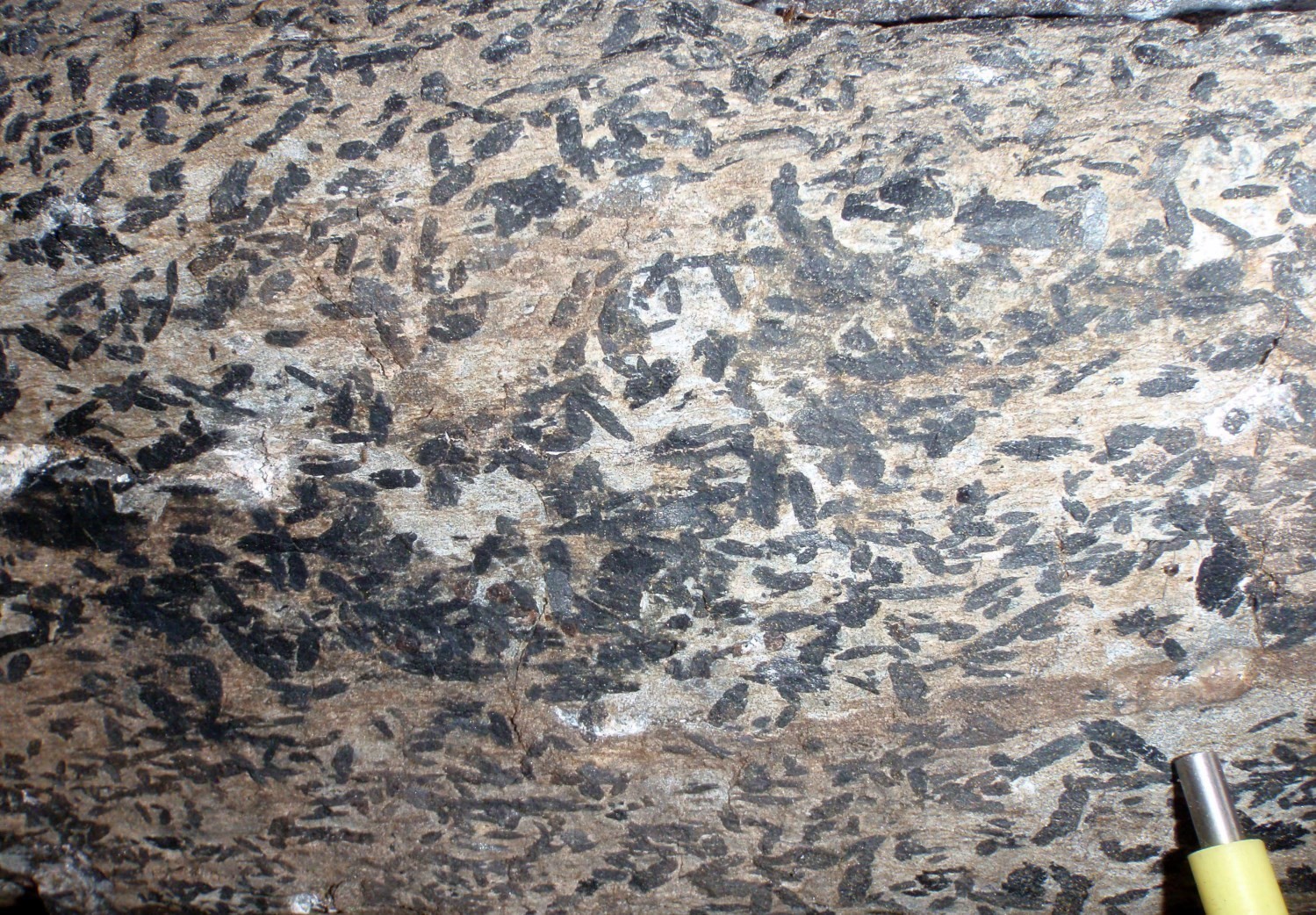
DISCLAIMER: This English version is translated from the original French. In case of any discrepancy, the French version shall prevail.
| Author(s): | Charette et al., 2016 |
| Age: | Paleoproterozoic |
| Stratotype: | None |
| Type area: | Jeannin Lake area (NTS sheet 24B) |
| Geological province: | Churchill Province |
| Geological subdivision: | Rachel-Laporte Lithotectonic Domain |
| Lithology: | Mafic calcosilicate rocks and carbonate gneiss |
| Category: | Lithodemic |
| Rank: | Suite |
| Status: | Formal |
| Use: | Active |
- Laporte Supersuite
- Préville Suite
- Klein Suite
- Freneuse Suite
- Secondon Suite
Background
The Préville Suite was introduced in the Jeannin Lake area (Charette et al., 2016). Penrose (1978) had previously described layered basic hornblende-tremolite gneiss in part of the area currently covered by the Préville Suite.
Description
The Préville Suite includes various facies of deformed and metamorphosed calcosilicate rocks. Two informal units, generally interstratified, were distinguished: biotite-amphibole-garnet carbonate gneiss of possible sedimentary origin (pPprv1), and amphibole porphyroblastic mafic calcosilicate rocks of uncertain origin (pPprv2). Unit pPprv2 is the main unit of the suite. Rocks of both units are well foliated and locally schistose. In the vicinity of faults and the contact with the Labrador Trough, grain size is reduced and chlorite is abundant. Moreover, amphibole and garnet porphyroclasts associated with muscovite pressure shadows (replacing biotite) are observed.
Préville Suite 1 (pPprv1): Biotite-Amphibole-Garnet Carbonate Gneiss, Possibly of Sedimentary Origin
Unit pPprv1 is a banded rock displaying alternating millimetric to centimetric light and dark green (20-35%) bands. Light bands are fine grained and have textures indicating partial recrystallization. They are composed of plagioclase, quartz, biotite and carbonate with local muscovite, epidote and apatite. Carbonates occur as euhedral crystals or interstitial zones. Dark bands are coarser grained, regularly lenticular and varied in composition. These bands can contain biotite only, or biotite, amphibole (hornblende and actinolite) and garnet. Amphiboles and garnet are commonly poikiloblastic and contain inclusions of quartz, muscovite, opaque minerals, chlorite and carbonate. Dark bands occasionally contain scapolite and opaque minerals. Carbonates also fill fractures. Biotite is locally chloritized, while hornblende is occasionally pseudomorphosed to chlorite ± biotite. When present, kyanite forms large crystals cutting banding and foliation. Finally, some bands contain small sillimanite rods exhibiting common extinction (former big crystal).
Préville Suite 2 (pPprv2): Amphibole Porphyroblastic Mafic Calcosilicate Rocks
The main unit of the Préville Suite is characterized by the presence of 1-10 cm-long porphyroblasts of acicular amphibole (hornblende, actinolite ± pargasite ± arfvedsonite). Sheaves grow in the foliation plane, defining a remarkable garbenschiefer texture. Amphiboles are usually poikiloblastic with many inclusions of plagioclase and, more locally, carbonate, epidote and chlorite. Unit pPprv2 consists of two main facies that alternate on the decimetric to decametric scale. In the first facies, porphyroblasts are surrounded by a very fine-grained whitish matrix composed of plagioclase and carbonate associated with a significant amount of zoisite in the matrix and as inclusions in amphiboles. The second facies shows centimetric to decimetric banding marked by alternating bands very rich in amphibole-garnet, and amphibole-garnet-biotite lenticular bands. These bands contain 5-40% very fine-grained recrystallized matrix composed of plagioclase, carbonate, small brown biotite felts accompanied locally by quartz and opaque minerals. Secondary minerals such as kyanite, sillimanite, staurolite, muscovite and scapolite are observed in varying amounts in this facies. Epidote, tourmaline, zircon (as inclusions in biotite), sphene and apatite are the main accessory minerals.
Two generations of amphiboles are observed in unit pPprv2: a first consisting of fine amphibole aligned in foliation, and a second forming non-oriented porphyroblasts that develop mainly on foliation planes. The edge of amphiboles is locally replaced by biotite. Garnet commonly forms porphyroblasts that overprint foliation. Amphiboles and garnet generally form clusters of several centimetres incorporating quartz and carbonate interstitial crystals.
Schists included in the pPprv2 unit are dark green and fine to medium grained. They are composed of actinolite, plagioclase, chlorite, carbonates and biotite. Penrose (1978) also mentions the presence of medium to coarse-grained white to light grey tremolite marble beds. This marble could correspond to the first facies described in the pPprv2 unit.
Thickness and distribution
The Préville Suite forms a sequence ~30 km long by 10 km wide in the western portion of the Jeannin Lake area, more specifically in sheets 24B11 and 24B12. It covers and area of close to 144 km2 in the Rachel-Laporte Lithotectonic Domain.
Dating
None.
Stratigraphic Relationship(s)
The Préville Suite is located in the structural extension of the Lemoyne Complex, located in the Labrador Trough ~60 km to the NW, in contact with the Rachel-Laporte Zone. This area has a structural grain that is rapidly shifting from NW-SE to E-W, a change likely associated with the presence of regional folds in contact with the Horseshoe and Wheeler complexes.
Rocks of the Préville Suite could correspond to carbonate metavolcaniclastic units possibly related to carbonatite and mafic tuffs of the Lemoyne Complex. However, its presence in volcano-sedimentary rocks of the Laporte Supersuite do not rule out the hypothesis that it may be a major metamorphosed alteration zone cutting mafic rocks of the Klein Suite and metasedimentary rocks of the Freneuse Suite.
Penrose (1978) and Dressler (1979) state that mafic gneiss could represent clastic sediments interstratified with mafic lava and ash flows in an underwater environment. In the Déborah Lake area, Girard (1995) describes calcosilicate rocks that also have a garbenschiefer texture (coarse amphibole sheaves in a fine-grained matrix) similar to that observed in unit pPprv2. In this area, these rocks have been assigned to a calcosilicate rock subunit of the Klein Suite (pPkle1c).
The characteristic composition and lithogeochemistry of these rocks justify the decision at this time to distinguish the Préville Suite as a particular stratigraphic unit. However, it is not possible to exclude the possibility of an association with the other Laporte Supersuite units (Lafrance and Vanier, 2021), namely the Freneuse and Klein suites.
Paleontology
Does not apply.
References
Publications Available Through SIGÉOM Examine
CHARETTE, B., LAFRANCE, I., MATHIEU, G., 2016. Géologie de la région du lac Jeannin, Québec, Canada. MERN. BG 2015-01, 1 plan.
DRESSLER, B., CIESIELSKI, A. 1979. Région de la fosse du Labrador. MRN. RG 195, 136 pages and 14 plans.
GIRARD, R. 1995. GEOLOGIE DE LA REGION DU LAC DEBORAH, TERRITOIRE-DU-NOUVEAU-QUEBEC. MRN. MB 95-20, 186 pages and 3 plans.
LAFRANCE, I., VANIER, M.-A. 2021. Domaine lithotectonique de Rachel-Laporte, sud-est de la Province de Churchill, Québec, Canada : synthèse de la géologie. MERN. BG 2021-01
PENROSE, B. 1978. GEOLOGIE DE LA REGION DU LAC HORSESHOE (NOUVEAU-QUEBEC). MRN. DPV 573, 39 pages and 1 plan.
Suggested Citation
Ministère de l’Énergie et des Ressources naturelles (MERN). Préville Suite. Quebec Stratigraphic Lexicon. https://gq.mines.gouv.qc.ca/lexique-stratigraphique/province-de-churchill/suite-de-preville_en [accessed on Day Month Year].
Contributors
|
First publication |
Isabelle Lafrance, P. Geo., M.Sc. isabelle.lafrance@mern.gouv.qc.ca (redaction) Mona Baker, P. Geo., M.Sc. (coordination); Thomas Clark, P. Geo., Ph.D. (critical review); Claude Dion, Eng., M.Sc. (editing); Céline Dupuis, P. Geo., Ph.D. (English version); André Tremblay (HTML editing). |



